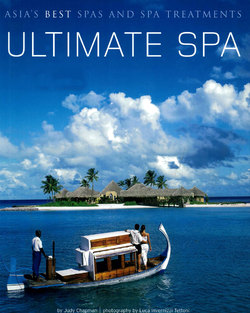Читать книгу Ultimate Spa - Judy Chapman - Страница 9
На сайте Литреса книга снята с продажи.
ОглавлениеAsia's best' spa treatments
Water is the soul of spa and reflects our inner beauty.
the world is our
spa
OPEN YOUR EYES AND LOOK AROUND. BENEATH YOU LIES THE EARTH, OXYGEN SURROUNDS YOU, BEYOND IS THE OCEAN AND EVERYWHERE THERE IS SPIRIT.
In the past the word "spa" was synonymous with European destinations, but today it has far wider connotations. As our appreciation of the need for health, beauty and rejuvenation grows, so too has the interpretation of the spa evolved.
This is especially true in Asia where many of the best spas and retreats now offer a variety of treatments drawn from many parts of the globe, albeit with an emphasis on those culled from the East. The huge storehouse of Asian wellness therapies blends life force, nature, water and kind healing hands with disciplines that have developed over the centuries. In the past we cleansed and bathed ourselves in natural sources of water; now, with the advent of spas, the ocean has become the thalasso pool, natural hot springs are onsen, and a variety of heat and cold therapies deriving from ancient steam bath practices have developed.
Returning the body to equilibrium—through ancient botanical recipes and time-honored rituals—is the prime focus of most Asian spas. Some treatments pay tribute to ancient bathing practices, others revisit beautifying treatments once administered in royal palaces, while others have been passed on by monks or local village healers. Disciplines such as martial arts, meditation and yoga practiced for centuries in monasteries and temples, are currently experiencing a renaissance. Most treatments originate from Asia's holistic medical systems, as in the past doctors were often healers, philosophers, shamans, monks and priests all in one.
An understanding of "life force," also known as body energy, prana, ch'i or ki that flows through all life forms and through the earth itself, is a vital element of the Asian spa. In Asian medicine, therapists and physicians work to free up stagnated energy to return the body to balance. Yoga, pranic breathing, massages, scrubs, acupuncture and more are all geared to stimulate this life force. Awareness of how energy flows through a nourished body is believed to be the key to health and longevity.
The hot stone therapy at Six Senses Spas works deeply into muscles and tissues with extremely rejuvenating results.
Asia's two oldest medical systems—ayurveda and traditional Chinese medicine (TCM) and the therapeutic treatments given by traditional healers in Indonesia, Malaysia, the Philippines, Thailand and Tibet—advocate that the world is an expression of our inner self. What goes on around us also resides within. Texts on ayurvedic medicine and yoga explain this in detail. Similarly, TCM is based on the belief that external appearances are not separate from inner organs and body functions; rather the outside manifestation is a mirror of that within. When eyes are radiant, complexion clear and body functions regular, it is thought that a person is in good health. Realigning our emotional and spiritual wellbeing is also a key factor in achieving a balanced body.
Exploring the origins of Asian's healing systems is a pilgrimage in itself, a tapestry that weaves together centuries of philosophies, practices and rituals. Since so many spas in Asia base their treatments on past modalities, it is important to consider how and why they evolved—as well as how they are offered in a modern-day environment.
The rebirth of ayurveda
Research suggests that the ayurvedic system of medicine was one of the first scientific methodologies to exist. Ancient texts, written some 5,000 years ago, are still being refined with many scholars sure that certain aspects of ayurvedic practice are at least 20,000 years old.
Translated from ayur meaning "life" and veda meaning "knowledge," ayurveda or the "science of life" is currently experiencing a global renaissance in spas and wellness centers. Legend has it that 52 scholars and rishis (sages) traveled to the Himalayas to gather life knowledge from the Vedic gods. Their intention was to find a solution that would give every person the tools to maintain his or her own health. Knowledge of health (which incorporated the physical, mental, spiritual and emotional) was never meant to be for the select few—and thus the philosophy behind ayurveda was born.
Regarded by many as the "medicine of the gods," ayurveda is laid out in the ancient Vedic texts. Although there are three Sanskrit ayurvedic texts containing the secrets of health and longevity, the most recent is the Ashtanga Hridayam by Vagbhata (600 Bc). This divides ayurveda into eight limbs or branches: kaya chikitsa or general medicine; shalya tantra or major surgery; shalakya tantra or treatments for ears, nose, throat, eyes and mouth; bhuta vidhya or psychiatry; bala tantra or gynecology and pediatrics; agada tantra or toxicology; rasayana tantra or rejuvenation; and vajikarana tantra or aphrodisiacs.
Frescos of heavenly maidens painted on huge rocks in Sigiriya, the Lion Mountain in Sri Lanka, depict royal ayurvedic beauty treatments.
A Thai mural painting showing royal bathing rituals.
Dr Rajeev Marwah at the Mandarin Oriental Dhara Devi Spa near Chiang Mai explains that ayurveda is "like a large river or an ocean with so much knowledge yet to be rediscovered." He says that the essence of ayurveda is to give people the inspiration to take care of their own health. The World Health Organization now recognizes ayurveda as a proven health system, and its ancient treatments, herbs and oils are continually being researched and refined.
